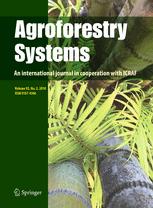Ver ítem
- xmlui.general.dspace_homeCentros Regionales y EEAsCentro Regional Patagonia SurEEA Santa CruzArtículos científicosxmlui.ArtifactBrowser.ItemViewer.trail
- Inicio
- Centros Regionales y EEAs
- Centro Regional Patagonia Sur
- EEA Santa Cruz
- Artículos científicos
- Ver ítem
Thinking in the sustainability of Nothofagus antarctica silvopastoral systems, how differ the responses of seedlings from different provenances to water shortage?
Resumen
Nothofagus antarctica, is the most important species of the silvopastoral systems of southern Patagonia. However, there is limited information on the ecophysiological response mechanisms of seedlings for survival under different resource availability regimes, and whether such processes may differ between provenances. In this study, we evaluated the functional response to water shortage of seedlings of four N. antarctica provenances grown under controlled
[ver mas...]
Nothofagus antarctica, is the most important species of the silvopastoral systems of southern Patagonia. However, there is limited information on the ecophysiological response mechanisms of seedlings for survival under different resource availability regimes, and whether such processes may differ between provenances. In this study, we evaluated the functional response to water shortage of seedlings of four N. antarctica provenances grown under controlled conditions. After an initial full irrigation period, seedlings were subjected to a water shortage cycle. Measurements of the diameter at the base of the stem, net photosynthesis (An), stomatal conductance to water vapour (gs), predawn water potential (Ψpd), osmotic potential at maximum and zero turgor (Π100; Π0), relative water content at zero turgor (RWC0) and maximum modulus of elasticity (Emax) were carried out during the experimental period. Differences between provenances concerning An and gs rates were recorded under full irrigation conditions, but were not detected in association with drought stress. All provenances had similar osmotic potential values (Π100 and Π0) at full irrigation, but water shortage led to significant osmotic potential differences between provenances. During the whole experimental period, no significant differences on RWC0 and Emax values were recorded among provenances. Under full irrigation conditions, all N. antarctica provenances had a similar physiological performance which suggests that environmental conditions may be the main driver for phenotypic differences in this species. From the osmotic adjustment results gathered, it is derived that a major osmoregulation capacity in response to water shortage is a common feature of all the N. antarctica provenances evaluated.
[Cerrar]

Autor
Bahamonde, Héctor Alejandro;
Sánchez-Gómez, David;
Gyenge, Javier Enrique;
Peri, Pablo Luis;
Cellini, Juan Manuel;
Aranda, Ismael;
Fuente
Agroforestry Systems 93 (2) : 689–701 (April 2019)
Fecha
2017-12
ISSN
0167-4366
1572-9680
1572-9680
Formato
pdf
Tipo de documento
artículo
Palabras Claves
Derechos de acceso
Restringido
 Excepto donde se diga explicitamente, este item se publica bajo la siguiente descripción: Creative Commons Attribution-NonCommercial-ShareAlike 2.5 Unported (CC BY-NC-SA 2.5)
Excepto donde se diga explicitamente, este item se publica bajo la siguiente descripción: Creative Commons Attribution-NonCommercial-ShareAlike 2.5 Unported (CC BY-NC-SA 2.5)

